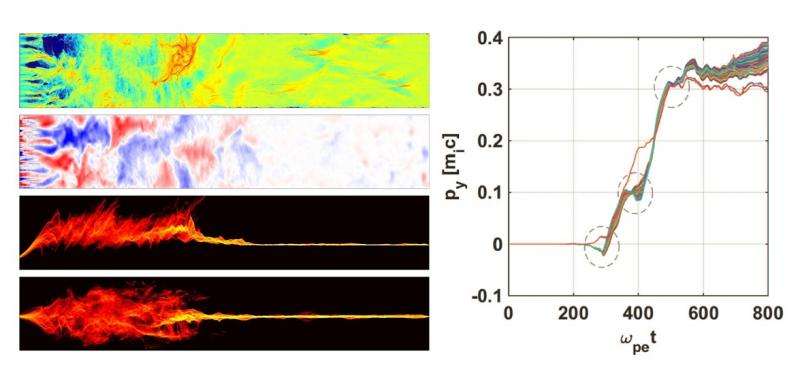Fermi-type acceleration of interstellar ions driven by high-energy lepton plasma flows

Stochastic acceleration and shock acceleration are well recognized as key mechanisms for cosmic ray generation since they were first proposed by Fermi. These two mechanisms have been widely investigated via analytical models and numerical simulations, but often modeled separately. According to a recent paper published in Science China Physics, Mechanics & Astronomy 58(10), 105201 (2015) by Cui et al., the two mechanisms can occur naturally in two sequential stages when a lepton flow propagates in a background interstellar plasma.
Even though many theoretical models have been proposed for the development of stochastic acceleration and shock acceleration, it is very difficult to verify these models based upon current astronomical observations. In the last decade, interest has increased in testing some theoretical models in laboratory, which has brought about a new field called laboratory astrophysics. In particular, the development of high-power laser technologies enables a variety of unique conditions to mimic some astrophysical processes at much reduced temporal and spatial scales. For example, some recent studies suggest that a lepton flow composed of dense electron and positron beams may be generated from relativistic laser-plasma interaction. Electron-positron jets are found widely in astrophysical environments such as quasars and black holes.
In their work, the researchers found that an electron-positron jet can drive a type of beam-plasma instability called the Weibel instability when it transports through a background plasma composed of electrons and ions. Strong electromagnetic turbulence develops as a result of the Weibel instability, which can accelerate background ions effectively. The accelerated ions form a perfect inverse-power energy spectrum, as expected for Fermi II-type acceleration. After a certain interaction period, the electron-positron jet further drives a collisionless shock wave in the second stage. Some ions can be trapped and accelerated further. This is the first time that the two acceleration mechanisms for energetic ions are illustrated clearly in a simple interaction configuration.
According to Prof. Z.M. Sheng, the corresponding author of this article from Shanghai Jiao Tong University and University of Strathclyde, the acceleration scenario discovered through their numerical simulations could be tested in the near future, given the fact that high-current electron-positron beams have been demonstrated recently in some laser-plasma experiments with high power lasers. Three years ago, Prof. Sheng and his collaborator Prof. G. R. Kumar from Tata Institute for Fundamental Research in India first reported the measurement of the turbulent magnetic field structures generated via the Weibel instability when a dense electron beam transports through a metal [PNAS 109, 8011-8015 (2012)]. Detection of ion acceleration from Fermi acceleration in laboratory would be extremely interesting, and is promising for our understanding of the origin of cosmic-rays, according to Prof. Kumar. When commenting on this work, Prof. J. Zhang from Shanghai Jiao Tong University, who is one of the pioneers in promoting laboratory astrophysics in China, pointed out that this work not only revealed very important new physics related to beam transport and Fermi acceleration, but also suggested the great potential of laboratory astrophysics for scientific discoveries.
More information: YunQian Cui et al. Two-stage acceleration of interstellar ions driven by high-energy lepton plasma flows, Science China Physics, Mechanics & Astronomy (2015). DOI: 10.1007/s11433-015-5715-2
Journal information: Proceedings of the National Academy of Sciences
Provided by Science China Press





















